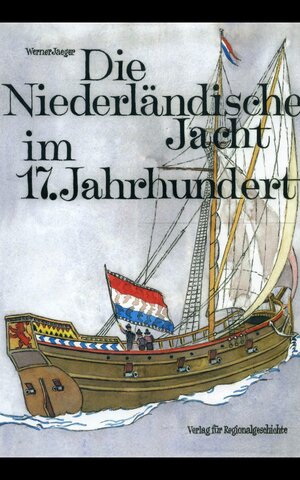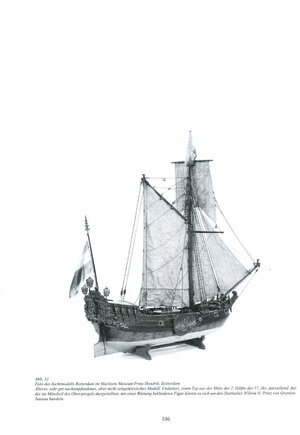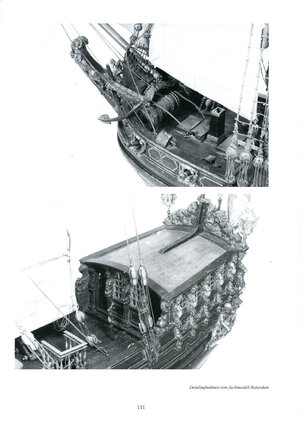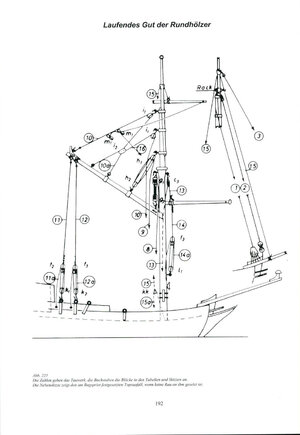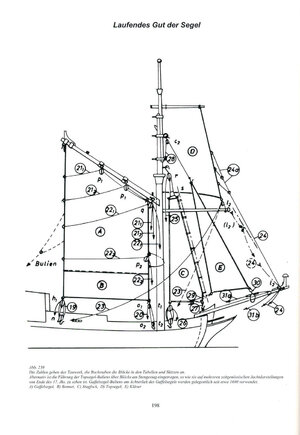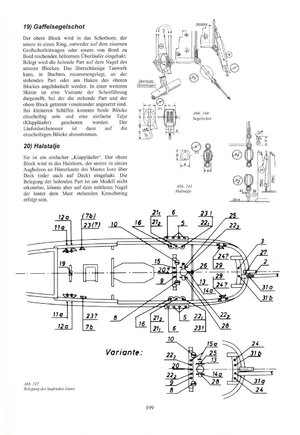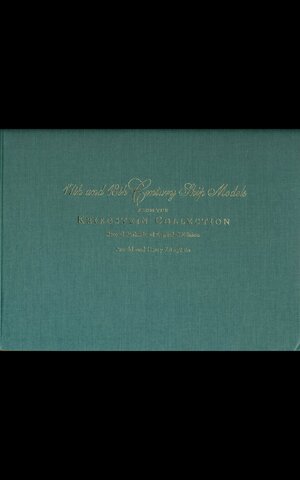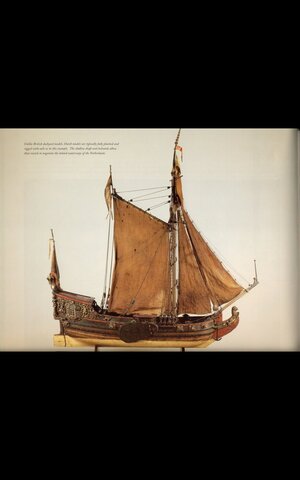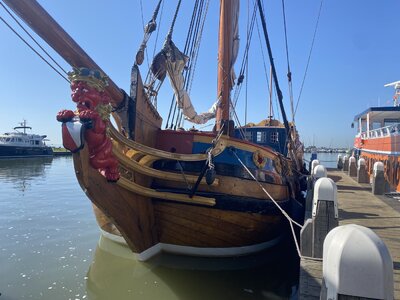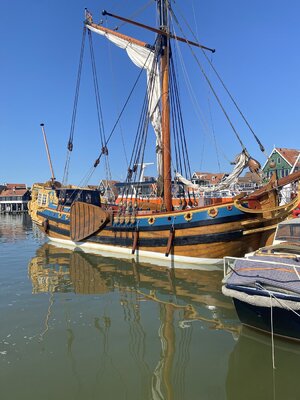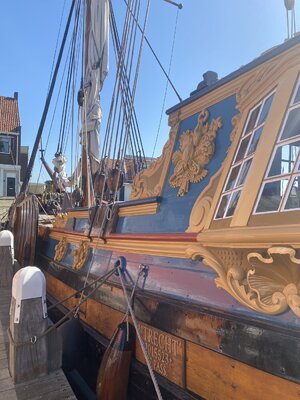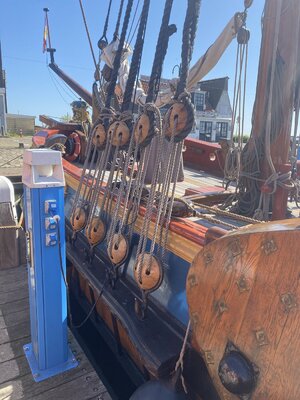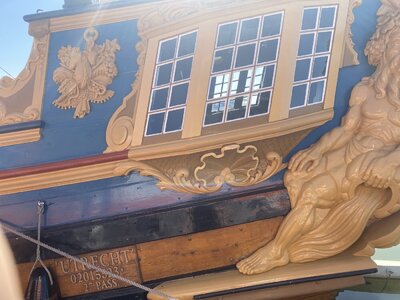Again it looks like the statenjacht has a new complete rigging, and again it is only half true. Over the last few days I have tried to draw up a plan of the standing and running rigging, how it could be as similar as possible to the original. This was and is not easy, because the photos from the museum in Amsterdam do not give an exact idea of the course of the ropes, and neither do the photos published by the museum itself. Now, the rigging of a single-masted vessel is not necessarily a closed book, but in detail there are many questions. I therefore decided to start by building a "draft rigging" to check where the individual blocks have to be positioned, where the ropes can be laid and - very important! - which exact dimensions the sails should have. In doing so, I have also drawn on other models of statenjachts from this period, for which there is already significant research, such as the "Utrecht", whose prototype dates from the same period as the Amsterdam model. Unfortunately, I used a light-coloured cotton yarn for the design, which can hardly be seen in the photo below.

The ropes are not tied
, but are only held taut with clamps so that, for example, the height of the gaff claw and the angle of the gaff can be easily adjusted until the final position of all attachment points is fixed.

In accordance with this design, I will now set to work on the standing rigging first.
And now a historical addendum. I had approached the great maritime historian Ab Hoving to ask if he knew anything more about the Amsterdam model. In his book about the Utrecht he had printed an apparently older (black and white) photo of the model. He then wrote to me that such models were by no means just toys for children. In fact, in the eighteenth century, entire naval battles were fought with large-scale models on ponds, and the ships even had "working" guns. He also referred me to a book by the Dutch maritime historian Gottfried Crone from 1926, which is dedicated to the multitude of smaller Dutch coastal and inland ships of the 17th and 18th centuries. The black and white photo in question can be found there. Together with the accompanying text, it proves that a restoration of the obviously badly damaged model had already taken place before 1926; in other words: even the present condition of the model can already be considered historical.
I can link the photo in question without violating any rights. It is figure four.
I have translated the relevant part from the description of the model in the text section:
Staatenjacht first half of the 18th century
Plate 4
Here we see a vessel of the type that followed similar vessels from the second half of the 17th century in the 18th century. Comparing it with the yacht of plates 1 and 1a, we notice that the hull is somewhat slimmer, there is no raised steering deck, and the ornaments are oriented towards the taste of the time. This model is one of two perfectly identical ones, both belonging to the Dutch Historical Maritime Museum. The one pictured comes from the estate of W. Six from Hilversum, the other, dated 1736, was in my possession for a few years and came from Friesland. Both are unmistakably made by the same modeller and have the same dimensions, differing only in the ornaments, the one pictured here being purer in style.
The hull was in a dilapidated state, probably a consequence of the fact that the model had served as a "Weiherschiffchen", also nothing of the rigging was preserved, the painting and the gilded ornaments, however, were in good condition, so that the restoration, which was carried out by the museum, could be limited to repairs to the keel and a new rigging. For this, the director made use of the exact data from the shipbuilding archive of the [shipbuilder] van Zwijndregt family [from Rotterdam], which had been donated to the museum by a descendant.
In other words, there was something like serial production. According to Ab Hoving, however, nothing is known about corresponding workshops. Moreover, it seems that the ornaments were actually gilded.
Schmidt

The ropes are not tied
, but are only held taut with clamps so that, for example, the height of the gaff claw and the angle of the gaff can be easily adjusted until the final position of all attachment points is fixed.

In accordance with this design, I will now set to work on the standing rigging first.
And now a historical addendum. I had approached the great maritime historian Ab Hoving to ask if he knew anything more about the Amsterdam model. In his book about the Utrecht he had printed an apparently older (black and white) photo of the model. He then wrote to me that such models were by no means just toys for children. In fact, in the eighteenth century, entire naval battles were fought with large-scale models on ponds, and the ships even had "working" guns. He also referred me to a book by the Dutch maritime historian Gottfried Crone from 1926, which is dedicated to the multitude of smaller Dutch coastal and inland ships of the 17th and 18th centuries. The black and white photo in question can be found there. Together with the accompanying text, it proves that a restoration of the obviously badly damaged model had already taken place before 1926; in other words: even the present condition of the model can already be considered historical.
I can link the photo in question without violating any rights. It is figure four.
I have translated the relevant part from the description of the model in the text section:
Staatenjacht first half of the 18th century
Plate 4
Here we see a vessel of the type that followed similar vessels from the second half of the 17th century in the 18th century. Comparing it with the yacht of plates 1 and 1a, we notice that the hull is somewhat slimmer, there is no raised steering deck, and the ornaments are oriented towards the taste of the time. This model is one of two perfectly identical ones, both belonging to the Dutch Historical Maritime Museum. The one pictured comes from the estate of W. Six from Hilversum, the other, dated 1736, was in my possession for a few years and came from Friesland. Both are unmistakably made by the same modeller and have the same dimensions, differing only in the ornaments, the one pictured here being purer in style.
The hull was in a dilapidated state, probably a consequence of the fact that the model had served as a "Weiherschiffchen", also nothing of the rigging was preserved, the painting and the gilded ornaments, however, were in good condition, so that the restoration, which was carried out by the museum, could be limited to repairs to the keel and a new rigging. For this, the director made use of the exact data from the shipbuilding archive of the [shipbuilder] van Zwijndregt family [from Rotterdam], which had been donated to the museum by a descendant.
In other words, there was something like serial production. According to Ab Hoving, however, nothing is known about corresponding workshops. Moreover, it seems that the ornaments were actually gilded.
Schmidt




